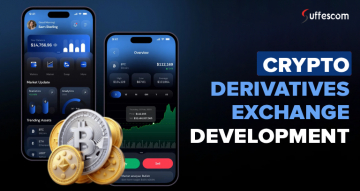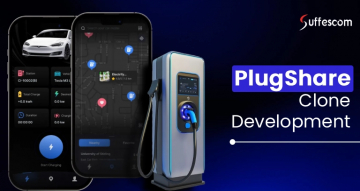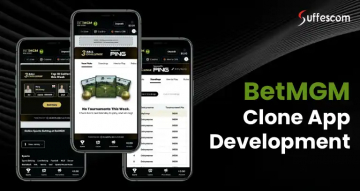Web3 Banking App Development | Web3 Banking Solutions

Web3 Banking App Solutions: A New Paradigm in Finance
Banking is changing fast. People want control, transparency, and instant access without middlemen. That’s exactly what Web3 banking apps deliver. Built on blockchain, these apps remove barriers, cut settlement times from days to seconds, and give users true ownership of their assets.
At Suffescom, we help financial businesses build secure, scalable Web3 banking platforms. From digital wallets to tokenized assets, our solutions are built to meet how banking actually works in 2025.
Here’s what Web3 banking really means, how it changes the rules of finance, and how you can build your own platform.
If you are too looking for sparkling technology that helps customers to access credit, wealth custody, and transfers of value with permissionless access. You are at the right place. Suffescom solutions a top White Label Digital Banking App & Platform, is a one-stop destination for all your web3 and blockchain technology needs. We build metaverse technology-related projects to cope with emerging technology and customer needs. Schedule a call with our experts now!
Why Web3 Banking is the Future of Finance?
Web3 banking apps aren’t just another upgrade. They’re a complete shift in how financial systems work. Here’s what drives the change:
Web3 Digital Wallet
Web3 applications support a digital wallet that allows individuals to make and record all electronic transactions, such as bill payments, mobile recharges, and travel/movie bookings. All these transactions are accessible to users through their mobile devices. Web3 digital wallet’s primary responsibility is to offer financial services to residents of remote locations with the help of Web3, especially those which are far away from traditional banks.
Decentralized Finance (DeFi)
Web3-based Decentralized finance or says DeFi platforms are designed to eliminate the need for middlemen and enhance transaction transparency through peer-to-peer networks. The system is powered by blockchain and cryptocurrency technology, forming an alternative to the traditional financial system. DeFi offers financial products to users without intermediaries like funds transfers and exchanges. Examples are Aave (AAVE) and Synthetix (SNX).
Decentralized Applications (dApps)
DApps or Decentralized Applications function on a specific blockchain network such as Ethereum, Solana, Polygon, etc. It allows users to lend, borrow, stake, and earn interest on deposits. Instead of using a single server, dApp allows transactions to happen between the network of computers. They are not subject to any dominance or interference. These apps are free from the control and interference of a single authority.
Decentralized Exchange (DEX)
A peer-to-peer marketplace where users can trade cryptocurrencies in a non-custodial manner without the need for an intermediary. It helps users to facilitate the transfer and custody of funds. DEX allows absolutely no need for a third party, as all transactions are made directly from the user's wallet and without adhering to any KYC requirements.
Revolutionize Your Banking Experience with Our Web3 App Solutions
Experience banking like never before - our Web3 app solutions are designed to revolutionize your financial management and deliver unparalleled user experience.
Traditional Banking vs Web3 Banking: Key Differences
| Grounds | Traditional Banking Apps | Web3 Banking App |
| Access | Permissioned +KYC+AML+Scoring | Public and trustless |
| Anonymity | Shattered | Compliant |
| Custody of assets | Held by custodian on owner’s behalf | Users owned in non-custodial wallet |
| Execution | Intermediaries | Via smart contract |
| Settlement | By Intermediaries after a period of time | Validation on underlying blockchain |
| Instruments | FIAT currencies | Crypto assets |
| Risk | Concentrated in single entity | Users distributed |
| Operation | Semi automated by service provider | Automated by smart contract |
| Data storage | CLT | DLT |
| Community incentives | Non-applied | Widely applied |
Features Of Blockchain-Packed Web3 Banking Platform Solutions
Quick Financial Transactions
Under the traditional banking system, transaction completion can take between 3 to 7 days, and if it’s an international payment, the days could be more. Now, with blockchain-backed web3 banking platforms, it shrinks to seconds only. Worldwide transactions can be settled with reduced fees from anywhere and anytime.
Blockchain-Based Credit Reports
Credit reports directly affect customers’ financial lives as it is related to their lending abilities. Blockchain-based credit score reports can impact users' lives more as anyone can check a report with the consent of the user and don’t have information tempering rights. Users can get high-quality, blockchain-based credit histories. It greatly affects consumers’ access to traditional credit services.
Contactless andCardless ATM Features
Recent advancements in technology, such as near-field communications and QR codes, make it easier for customers to access ATM machines using their mobile devices. Same lies with web3 banking apps that eliminate the need for physical cards and passwords. Web3 DeFi platform also continues the same trends to extend to include QR code features as well as apps like Apple Pay and Google Pay.
Voice-Enabled Banking
Web3 banking application data collection and machine learning algorithms can enhance customer experience and provide personalized service with advanced chatbots and voice technology. Natural language processing helps users to avail faster services, predict spending and provide suggestions for managing finances.
Automated And Personalized Suggestions
Automation of payments expands beyond bill payments to other utilities, such as helping consumers save money. Web3 banking apps are embedded with advanced reporting tools, utilizing AI, algorithms, and machine learning that helps to analyze spending patterns and create more savings strategies for customers.
Tokenized Assets
Many reputed banks tokenize their digital assets such as bonds, shares, stocks, debentures, and more. This helps banks for a seamless trading experience, and smart contracts enable minimizing risk and maximizing returns. Some banks also turned their high-value assets, such as diamonds, into NFTs.
Central Bank Digital Currencies (CBDCs)
In most parts of the world, banks are already working on the cryptocurrency that supports banks. Some countries develop plans to launch digital currency in 2024 before it becomes an ultimate choice. This currency is believed to be treated as bank notes under financial regulations and as fiat currency as well.
Game Monetization
These Days, online gaming platforms are gaining popularity at an immense speed. Web3 banking apps support many of these recommended apps to play and earn money. The real-time transfer feature can enable the transfer of funds into real currency in less time.
Unlock the Potential of Web3 Banking App Solutions
With our Web3 banking app solutions, unleash the full potential of next-gen banking and revolutionize your financial future.
Use Cases For Web3 in Banking App Development
These are some possible uses of Web3 banking App Development;
Tokenized Assets And Securities
Investment banks already use tokens to represent custom bonds, securities, stocks, shares, and other assets. Tokenization can bring two advantages.
- Creating customized bonds and securities for a seamless transactional experience.
- Smart contracts can enable assets to trade faster and more securely. The whole transaction is based on minimizing risk and maximizing return-based algorithms.
Central Banks Back The Digital Currency
The federal or central banks in many countries are currently working on digital currency that banks can accept. Currently, there are 13 crypto-friendly banks, and the list continues to grow. These are
- Revolut
- Quontic
- Ally Bank
- USAA
- Bank of America
- Goldman Sachs
- Juno
- Wirex
- Fidor
- Bankprov
- JPMorgan Chase
- Monzo
- Simple
Monetization of Games Through Bank Payment Options
Online gaming is also rapidly gaining popularity. Banks that are using web3 banking services now allow payment integration in the virtual world. NeoBank is a prominent example of it. The bank allows users to transfer value from the virtual world into the real world. Banks hold the gaming tokens, and players that are using them can raise a loan in exchange for tokens.
Virtual Banking
We all know the metaverse is going to become the future of the internet. Creating a web3 banking application can help you to avail all the benefits of services offered in the metaverse world. These will allow consumers to use their avatars to visit a virtual branch of a bank, interact with staff, and make transactions online. Also remote services have also become a popular trend since the pandemic. Users can interact with banks and avail of services from their own space. Financial planning, financial reviews, and virtual portfolio reviews can all be made possible by the metaverse.
Employee Onboarding
The metaverse in Web 3 allows for 1:1 virtual meetings and employee training. Banks can avail the benefits of these technical capabilities to bridge communication gaps between employees in tier 2 or tier 3 cities and employees from tier 1 cities. It can foster strong employee bonds and simplify the customer-handling process, and it makes the whole banking process easier and more efficient.
Our Web3 Banking App Development Process
The process of web3 banking app development can somewhat vary on an individual basis. However, the following seven steps are ones that you’ll likely have to go through:
Strategy Development
The very first step of the web3 banking app development process is to define the strategy. For this, our experts gather essential information by identifying your business objectives, understanding competitors and problems your app will solve, targeting users, and determining what results in your business plans to achieve. Also, we work on platform selection and monetization methods to make direct money from apps.
Analysis and Planning
The second step to take in the process of web3 application creation is analysis and planning. Now you have an idea in mind, have done some research, and are about to start the design and development phase. At this stage, you are much more likely to prepare for the future and make a detailed plan to end the goals you’ve set. At this stage, you also work on Blockchain development solutions to be used and other tech stacks to build a platform.
UI/UX Design
In order for users to get the best experience, applications need lots of attention. If it is messy or faulty, users will immediately flock to competitors. Therefore, this stage involves what data will be present within your banking app, how it will be displayed, and how the users will interact with it. A digital sketch called a wireframe is crafted to ensure that the finished application is intuitive and seamless to use. Moreover, designers work on Fonts, Color schemes, Spacing and positioning instructions, Buttons, Widgets, and Other relevant design elements.
App Development
Now, the design phase is complete, and it’s time to move on to the main part of the web3 banking app development process. It is made up of two main parts — backend and frontend. The backend stage involves creating databases and server-side objects that are responsible for your platform performance. Frontend is a stage where your users will interact. In this approach, our blockchain developers focus on three approaches - Platform-specific, Cross-platform, and Hybrid.
Application Testing
Once you’re done with app development, it’s time to begin testing. At this stage, we make sure our solution is stable, secure, and doesn’t have any bugs. As a trusted Web3 Testing Services brand we provide web3 functional testing, web3 unit testing, and web3 penetration testing for the decentralized applications. Our experts undergo five testing methods prior to deployment. These involve functionality, performance, security, platform and device, and extended review. Before proceeding to deployment, we conduct 360-degree testing of your application with its actual final users.
Deployment
When your application is finally ready to deploy, we go through different distribution models depending on the platform's development. We submit your application to Apple’s App Store, Google’s Play Store, or go for private distribution, as per your instructions.
Support and Performance Monitoring
Once your app is finally live, and users are steadily downloading it — it’s time to get your analytical hat on and monitor performance.
Some of the most important KPIs that we pay attention to are:
- App downloads
- Active users
- Average visit time
- Retention
- Churn
- Conversions
- Customer lifetime value
- Reviews
- Ratings
Cost of Web3 Banking App Development
An average cost for Web3 banking app development can range between $70,000 to $300,000 based on the complexities of features and functionalities. More, platform development locations, experts hired, blockchain technology, and development tech stacks used are other essential factors affecting platform cost.
Why Choose Suffescom for Web3 Banking App Development
Now you are aware of all of Web3 Banking Platform Solutions development, it's time to take the initiative and turn your banking platform into a secured banking platform. With a reliable web3 platform development company Suffescom Solutions Inc., you can start building your project right away. Here are some reasons to choose us;
- Web3 platform development
- NFT Marketplace Development
- Web3 Integration Services
- Blockchain consultancy services
- Token development
- Crypto Banking Solutions
- Customized crypto wallet development
- 24*7 customer support
- Blockchain technology passionate development team
Get in touch to discuss how your Banking business might use web3 to connect with new customers and opportunities.
FAQs
1. What is a Web3 banking app?
A Web3 banking app is a decentralized financial platform that runs on blockchain, offering direct ownership, instant transfers, and transparent operations.
2. How much does it cost to develop a Web3 banking platform?
Costs range from $70,000 to $300,000 depending on features, blockchain integrations, and design requirements.
3. Can Web3 banking apps work with traditional banking systems?
Yes. They can be integrated with APIs for hybrid solutions that bridge Web2 and Web3 banking.
4. How secure are Web3 banking apps?
They use blockchain’s immutability, cryptographic security, and smart contracts to minimize fraud and data breaches.
5. What features should a Web3 banking app include?
Digital wallets, DeFi integrations, tokenized assets, on-chain credit scoring, and CBDC support are key.
6. How long does it take to build a Web3 banking app?
Typically 4 to 8 months, depending on the scope and complexity.
7. Can Web3 banking apps handle tokenized assets?
Yes, tokenization is a core feature, enabling secure trading of digital and real-world assets.
8. Can Web3 banking apps connect to my existing bank account?
Yes, our Web3 banking solutions can integrate with traditional banking systems through APIs, allowing seamless fund transfers between your existing bank accounts and Web3 wallet.
9. Do I need crypto knowledge to use Web3 banking?
No, our Web3 banking apps are designed with user-friendly interfaces that hide complex blockchain operations. You can use them just like regular banking apps without understanding cryptocurrency technicalities.
10. What makes your Web3 banking different from existing fintech apps?
Our Web3 banking offers true decentralization, instant global transactions, tokenized assets, DeFi integration, and complete user control over funds, unlike traditional fintech apps that still rely on centralized banking infrastructure.








